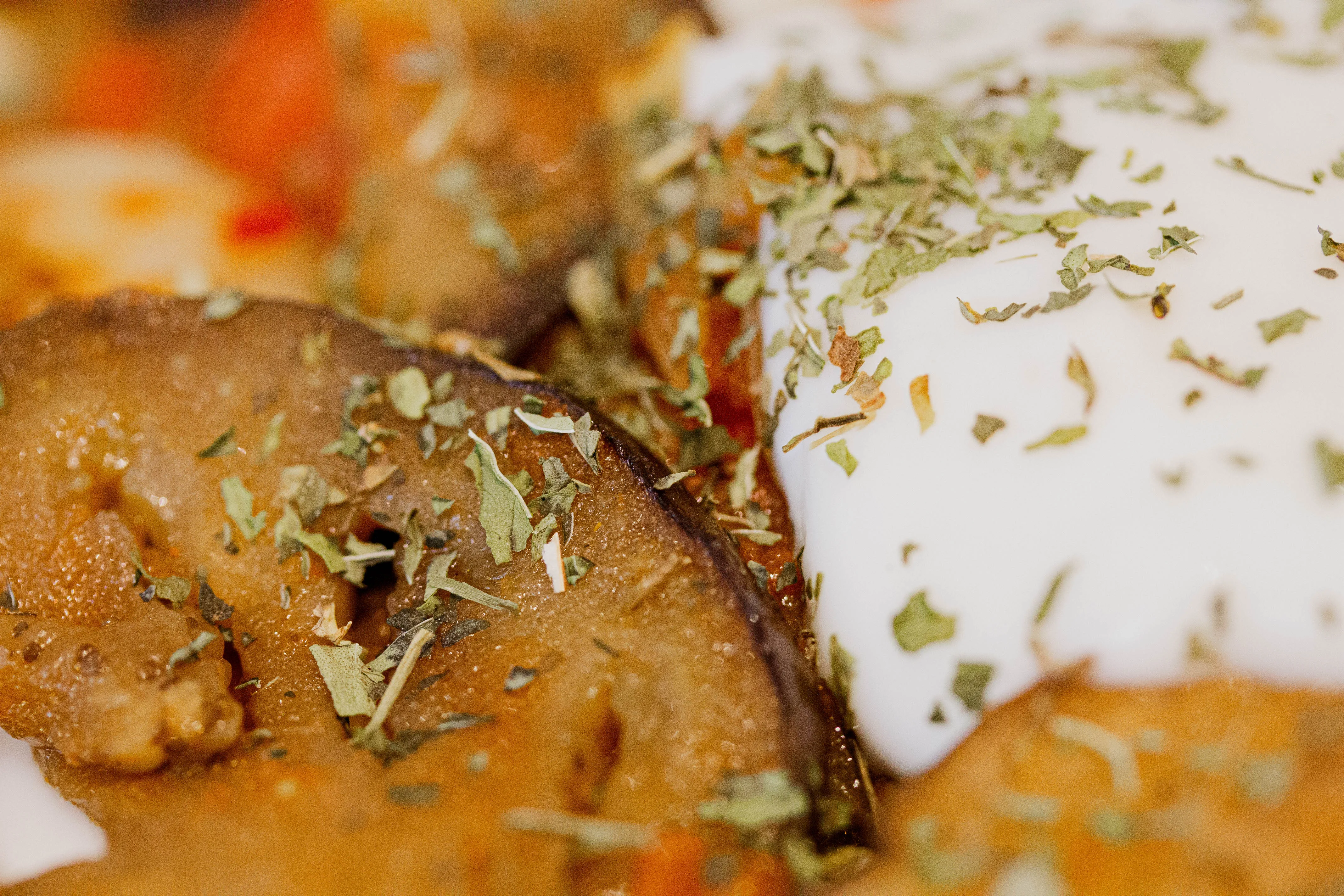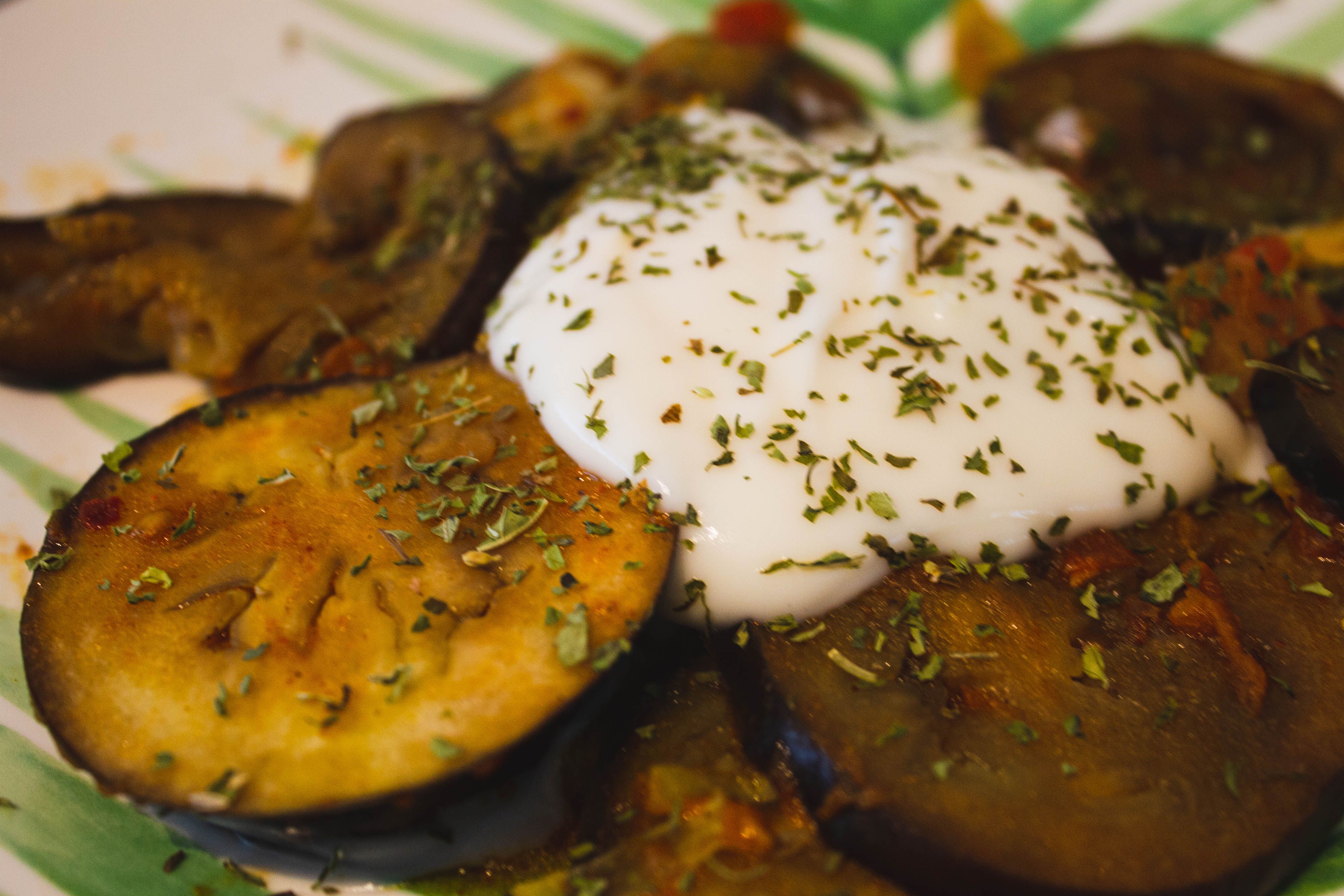A longer and more detailed description
Step-by-step instructions
Ordinarily, these would include pictures, but I was dumb and got my lighting all wrong, so I have no pictures. I’ll try to be descriptive enough that pictures aren’t needed.
Begin by arranging your ingredients in a pleasantly aesthetic way on the kitchen counter, bar, table, or wherever you arrange ingredients. I used the aubergines to create a nest for my onion so it didn’t roll away, but don’t feel obligated to do this. Let that onion be free if it chooses to be. We are all the arbiters of our own destinies.
Heat a pan with a thin layer of oil over medium heat. Wash and chop your aubergines into disks. The recipe calls for three aubergines, but really, this recipe is dependent primarily on the size of your pan and your love of aubergines. Note, though, that the aubergines do shrink pretty dramatically as they cook, so you can fit more aubergines into the pan space than you give yourself credit for. Think of this like an episode of Taskmaster, where you never really know what an aubergine is capable of until you are forced to see how much of it you can fit in a too small space. Once you’ve sliced your aubergine, toss it into the oil. Wash it sizzle. Enjoy that sizzle, for you are the master of the flame.
Chop your onion into rings and add it in with the aubergines. Cook these two lovelies together until the aubergines begin to brown, which takes around three to five minutes, depending on how you define “medium heat.” Once the aubergines turn brown, remove them from the heat and set them aside.
In a second pan - or the first again, if you remove the vegetables from the pan and put them somewhere else, but more conveniently, a second pan - heat more oil over medium heat. Mince two cloves of garlic and add them to the heat, again, pausing to watch them sizzle. Either before or while, depending on how confident a tomato dicer you are, dice your tomatoes. Once the garlic begins to brown - within one or two minutes - add in your tomatoes, cayenne pepper, curry powder, and salt. The recipe calls for a half teaspoon each of cayenne and curry powder, but don’t feel you’re limited to that. Express yourself and be creative here. If you hate spiciness, add less. If you want to make your mouth sing, add more. The world is yours to explore. Additionally, if you are using hot chilis, add them in here. If you’re not, don’t.
Cook the tomatoes, garlic, and spices until the tomatoes begin to dissolve and become saucy. You’re looking for tomatoes that will hurl affable insults, not ones that have become jaded and cynical by their new reality. The process of saucifying the tomatoes should take five to six minutes.
Add your aubergines and onions to the saucy sauce, then add water to help mellow things out and give everyone some space to simmer down. Cover the aubergines and onions with as much sauce as possible, then cover the pan, lowering the heat and letting everything simmer for ten minutes.
While the veggies cook, it’s time to make the garlic yoghurt sauce. Peel your remaining clove of garlic. Fun cooking tip! The internet will tell you that if you cut the end off a garlic clove, then press the garlic with the flat of a knife until you hear a little crack, then cut the other end off the garlic, the skin will come off in one piece. That may make working with fresh garlic easier, if you usually use pre-minced stuff. I’ve never gotten this to work, though, and dislike peeling garlic. The flavour of fresh garlic is worth it, though.
After enduring the ordeal that is peeling garlic, finely mince the garlic. You can also grate the garlic into the yoghurt, but I didn’t feel like it, so I minced the garlic instead. Add the garlic into the yoghurt, then give it a good stir.
Once the tomatoes and vegetables have stewed for long enough, it’s time to plate the dish! Serve this dish by placing two dollops - or more, you do you - on a plate and flattening them with the back of a spoon to create a nice little circle for the aubergines to nestle in. Scoop some of the aubergines and tomato sauce on to the yoghurt sauce, then add two more dollops of the yoghurt sauce on top of this lovely affair. Sprinkle everything with dried mint, or, if you’re not me and really enjoy fresh mint, add fresh mint leaves. Serve with warm naan, but not the naan I got at the grocery store. Actual naan. Nice naan. Good, fluffy, delicious naan.
خپل خوراک نه خوند اخل!ا
 I brought out my macro lens for this unhelpful picture of aubergines, mint, and yoghurt. Enjoy.
I brought out my macro lens for this unhelpful picture of aubergines, mint, and yoghurt. Enjoy.
Substitutions and suggestions
For the yoghurt: Yoghurt is the heart of this dish, so if you can find vegan yoghurt, absolutely do so. However, if vegan yoghurt is not available, or prohibitively expensive, or you don’t want to get something to just use for a single recipe, I got you. The yoghurt can be substituted with coconut cream, or if that is not your thing, silken tofu, blended and mixed with plant-based milk until you get a yoghurt-like liquidity. Note that neither of these will correctly mimic the flavour of yoghurt, but they get close to the texture. If you do go this route, I highly recommend adding lemon juice to your chosen substitute, and adding more of the cayenne and curry powder to offset either the coconut flavour or the blandness of the tofu, depending on which you use. You can also add extra garlic for the same effect.
General suggestions: I enjoy spicy food, so added in the chili flakes and mini chilies. They add body and kick without being overwhelming, but again, entirely up to you.
What I changed to make it vegan
In a cuisine full of meats and fish, it’s fantastic to find a food that’s already naturally vegetarian. All that had to be changed for this recipe, then, was swapping out dairy yoghurt for non-dairy. Et voila, the dish is vegan!
A brief context for this food
Afghan cuisine is a very unique blend of foods and flavours that reflects the complex history of Afghanistan and its people. It lies at the heart of the Silk Road, and as such, has been influenced by the myriad travelers who passed through it. This blending of culture and culinary traditions also becomes clearer when you consider the history of Afghanistan. Afghanistan has been part of numerous empires, ranging from Alexander the Great to the Sassanids to the Timurids. It has been considered part of Persia, part of India, and part of Uzbekistan. Indeed, the modern conception of Afghanistan is a fairly recent thing. The Emirate of Afghanistan was founded in 1823, and even then, it was an amalgamation of various smaller polities. The modern ethno-linguistic divide within Afghanistan between the Pashtuns and Farsiwans (and I know Farsiwan isn’t an ethnicity, but this is a recipe, not a comprehensive history of Afghanistan) reflects this complex history. Afghanistan gained its independence from the United Kingdom on 19 August 1919, which is a delightfully satisfying combination of day and year. Its modern history is one of coups, attempted reforms, and more coups, as well as playing host to the machinations of its neighbours. With invasions by the Soviet Union and the United States shaping its modern history, and the pressures of Pakistan leading to the rise of the Taliban, Afghanistan’s history is a complex one.
Afghan cuisine draws heavily from Persian, Indian, and Central Asian cuisines, with its heavy incorporation of yoghurt, lamb, naan, and kebabs. It also uses a lot of spices that look familiar to anyone familiar with Persian and south Asian food, such as cinnamon, cardamom, and saffron. The cooking techniques are also similar to those you’ll see in a Hindustani or Persian kitchen, with spice-laden sauces and lots of rice.
Borani banjan specifically finds its roots in Persian cuisine, but, like any food, has been adopted wholly into the Afghan tradition and made distinct from its Persian roots. Borani more generally is a yoghurt-based salad, though the term has different meanings in different areas. While borani banjan is specifically made with aubergines and tomatoes with a garlic-yoghurt sauce, boranis more generally can be made with a wide variety of vegetables, meats, or grains. The main tie between them is the garlic-yoghurt base, and even then, it’s a flexible bond.
While I struggled to find the exact history of borani banjan specifically. Margaret Shaida’s “The Legendary Cuisine of Persia” suggests that borani banjan originated in the court of the Sassanid queen Boran (630-632 CE). Shaida’s version of the story is that Boran, tired of the same meals every day, asked her cooks to prepare something new. These dishes that combined yoghurt and vegetables became known as “borani” in honour of the queen. I am, however, sceptical that this is the actual history of borani, as we can find references to similar style dishes throughout the Mediterranean and Indian subcontinent. As Aglaia Kremezi and Anissa Helou point out in their work, “What’s in the Name of a Dish?” there are dishes named “borani” or some variation thereof throughout the Mediterranean, Central Asia, and the Indian subcontinent. What seems more likely is that the dish has some common ancestory, likely in Persia, that spread along the Silk Road and traders, and became endemic to a large swath of the world.
However, its journey unquestionably originates in Persia. While Persian varieties are cold, borani banjan was adapted to become a warm dish, with hot peppers and warm vegetables providing heat during cold Afghan winters. I hope it brings you warmth and joy as well.

 I brought out my macro lens for this unhelpful picture of aubergines, mint, and yoghurt. Enjoy.
I brought out my macro lens for this unhelpful picture of aubergines, mint, and yoghurt. Enjoy.